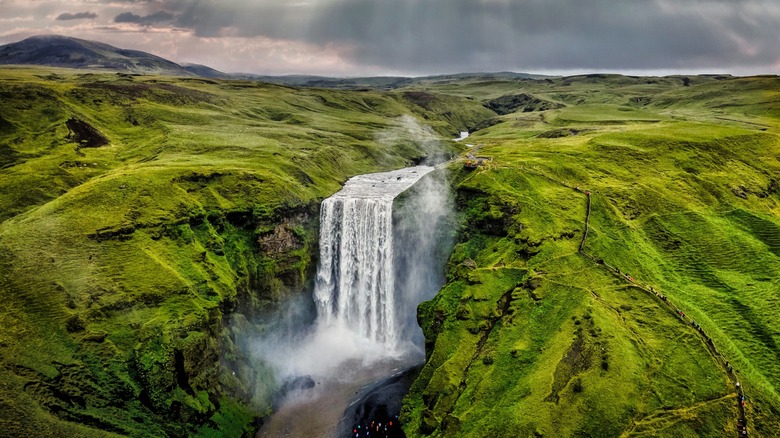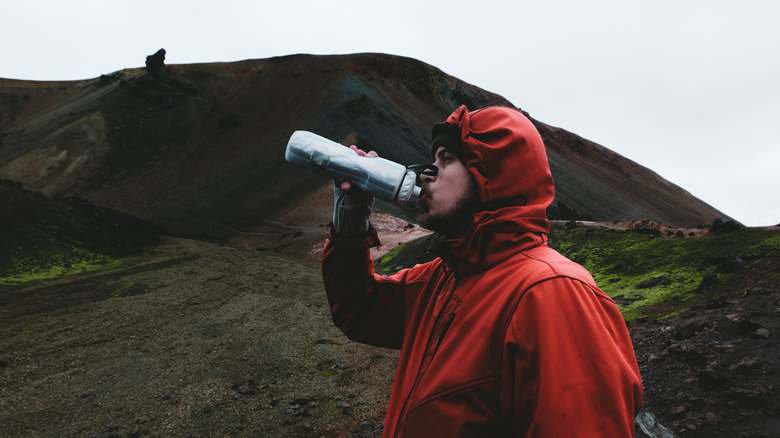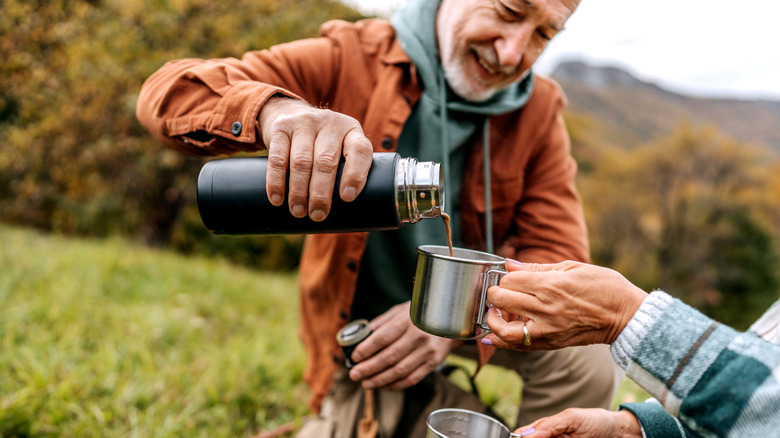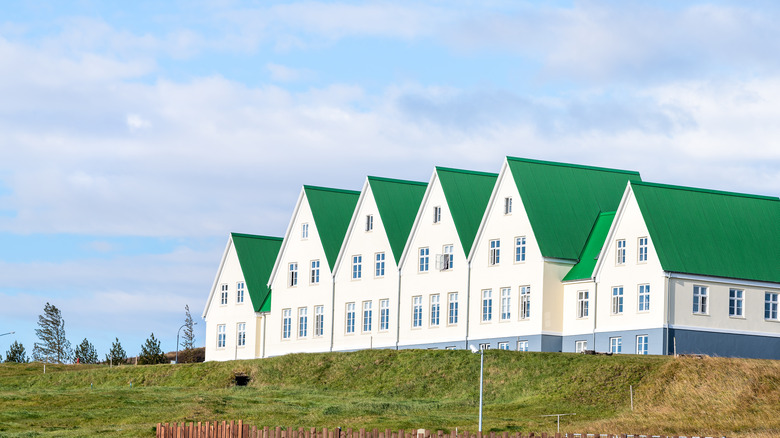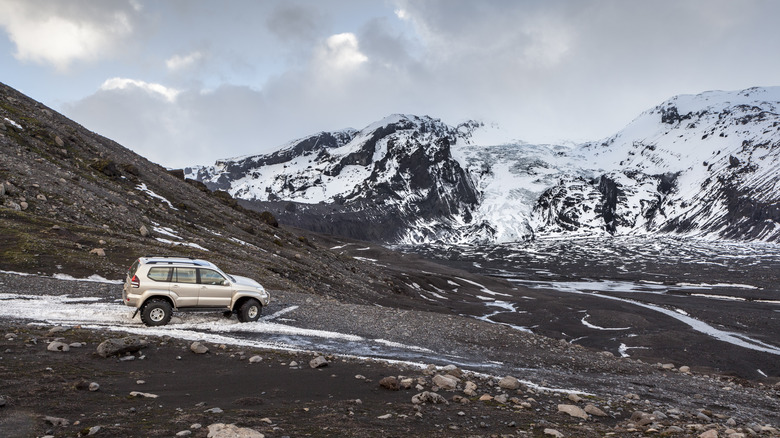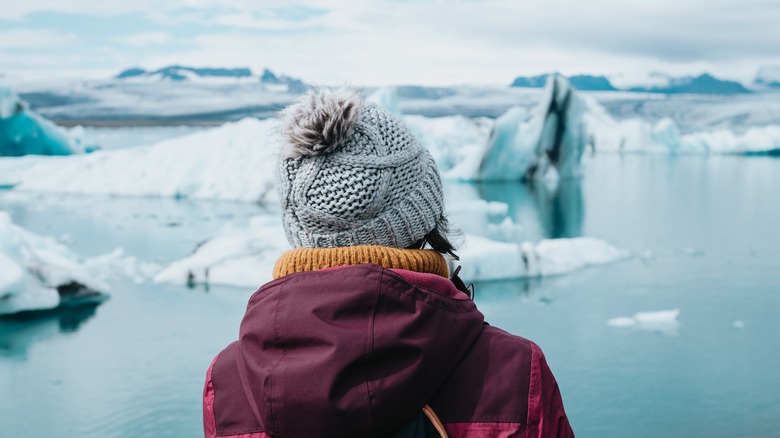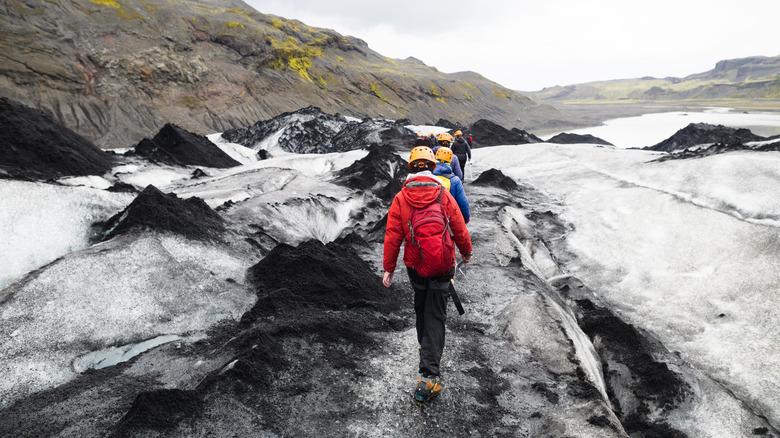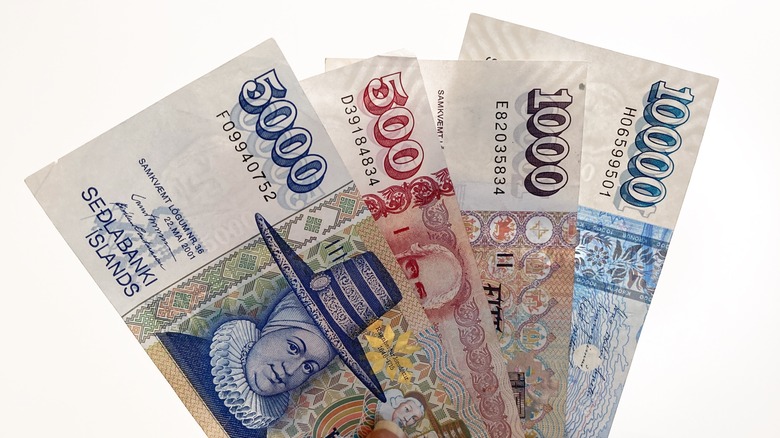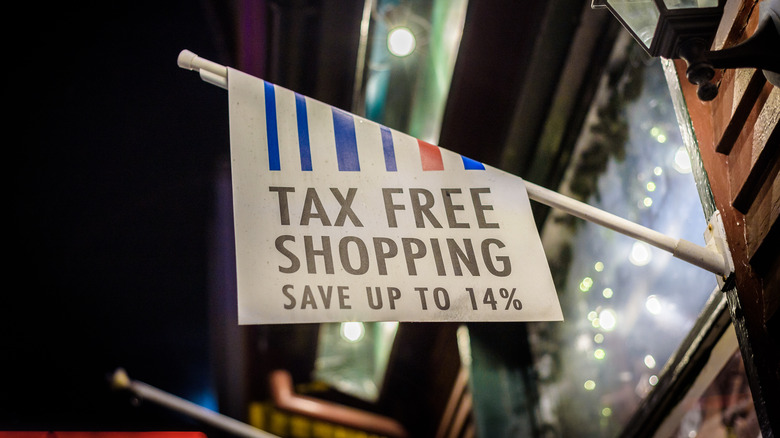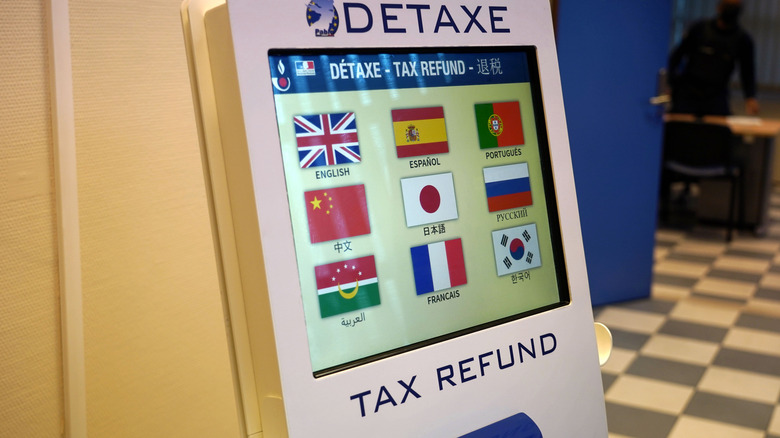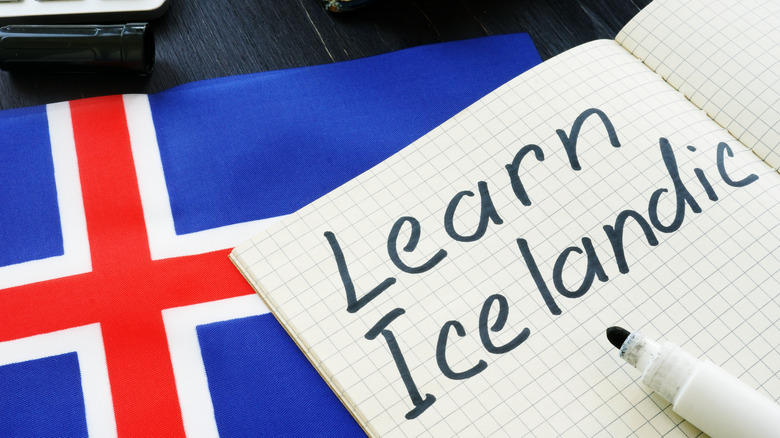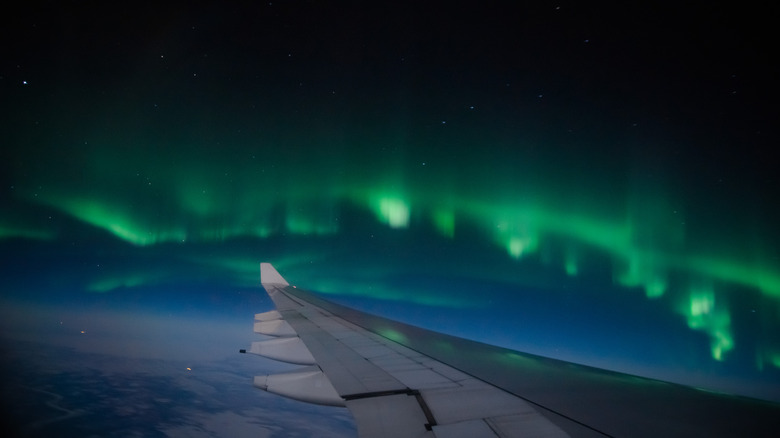Don't Take A Vacation To Iceland Without These Essential Travel Hacks
Ever heard the old rumor that Iceland was named as such to keep people out of an otherwise green country, and the name Greenland was a joke to trick visitors? Turns out we've got that rumor all mixed up. Iceland was allegedly named by the Viking Flóki Vilgerðarson, who hated the place so much he dubbed it Iceland after the frostbitten island robbed him of his daughter and his livestock. Greenland, on the other hand, was much greener back in the day — regardless, it received its name to encourage immigration to a not-so-enticing place.
Fast forward to the modern day, and no one is fooled by Iceland's misleading name when they look at its spellbinding volcanic slopes, so verdant they make your jaw drop. It's become one of the most popular tourist destinations for nature lovers and the filming location for countless movies and shows — "Star Wars," "Game of Thrones," and "Interstellar," to name a few.
For all its charm, though, Iceland is a faraway, frigid little island known for being prohibitively expensive. Visitors can't expect just to show up and wing it. Even if you only plan to spend all day swimming in Iceland's Blue Lagoon, some planning will go a long way. Here are a few essential travel hacks you can't vacation without in this fascinating Nordic country.
Bring a reusable water bottle
Most places in the world have to either treat their water or advise visitors never to drink from the tap. Iceland does neither. 95% of its potable water comes from natural, pure springs. That's right; the water out of the pipe has no added chemicals. It's 100% safe to drink, thanks to natural lava and rock filters. Some of it may acquire a sulfuric smell when hot, but it's perfectly safe to shower in — and is scientifically proven to be better for your skin. It's so clean, in fact, that in some places, you can swim in geothermal wastewater.
Never spend a cent on bottled water in Iceland if you don't have to, especially since bottled water in Iceland will run you about $2 a pop on average. Get yourself a quality metal or plastic water bottle and fill it up whenever you can. There are even some spigots out among the glaciers and frozen streams that let you drink it straight from the source. You'll save money and enjoy some of the freshest water Mother Earth has to offer. Plus, you can turn your water bottle into an emergency camping lantern in a pinch.
Bring a thermos
While you're searching for that water bottle, consider choosing a vacuum-insulated thermos. Though the Iceland moniker isn't completely true, it's at least accurate where the weather is concerned. Winter temperatures plunge as low as 14 degrees Fahrenheit, with summer averaging out at a nippy 54 degrees Fahrenheit. Iceland's isolation leads to everything being expensive, and the prices of hot drinks and meals at gas stations or cafes might singe your eyebrows off. That thermos can help to keep you warm and cut down on costs.
The obvious solution is to use it to bring around your coffee, tea, and hot chocolate. But it can also curb the discomfort of a rumbling tummy when you need a quick bite. Keep it full of piping-hot water, and you can make a cup of instant noodles even if you're standing on the peak of a glacier. The cool part is that you can refill it using Iceland's heated geothermal water when beyond city limits, which is how most places get their heated water anyway.
Choose guesthouses, not hotels
The economics of Icelandic accommodations lead to them being expensive whether or not the Icelanders like it. Small island, big influx of tourists, you do the math. Most people just bite the bullet and find Reykjavík's cheapest hotel, but we recommend trying a guesthouse instead. This is one of Iceland's best open secrets, costing much less than competing accommodations. An average stay at a guesthouse runs you about $125, compared to hotels at an average of $150.
Do keep in mind that guesthouses are more akin to hostels, with some featuring shared accommodations or small private rooms. If you're more adventurous — and would like a more rural experience — you can try a farm stay. These are remote farmhouses and cottages way, way out in the boondocks where your only company will be sweeping mountains. Some are situated on working dairy farms where you will spot roaming sheep and cows. Farm stays lend themselves more to group accommodations and thus may help to save some money per head.
Use discount programs for gas
There's one aspect of Iceland that would surprise the average visitor: gas station culture. Icelanders need their vehicles to traverse the two-lane highways and rugged mountain roads, so gas stations have become an all-in-one store for not just food but groceries and retail. Believe it or not, locals will congregate at these gas station restaurants when spending time together on a weekend off. As cool as this is, it doesn't change the fact that gas is one of the most expensive things you can buy during your visit — so you'll likely be desperate for an easy way to save on gas.
Make sure to get on board with the local gas discount loyalty programs. Every station brand has one. In most cases, your rental car key may include a smart fob and a brochure detailing the benefits. Some visitors might ignore this, thinking it's just like the forgettable loyalty programs in the U.S., but don't make that mistake. Aside from discounted gas, some offer free coffee and discounted food. Inquire with your rental car company for more info.
Get a 4WD or 4x4 vehicle
Beauty comes at a price, and Iceland's price is a punishing environment unkind to human life. Most of Iceland's roads are narrow stretches with small shoulders surrounded by stunning nature you'd be hard-pressed to find elsewhere. To access that nature, though, you'll need to take what is known as an "F-road." These are anything that's unpaved, typically gravel, leading off the beaten path. Expect steep inclines, river crossings, and, of course, unspoiled vistas that the tour bus hordes won't be getting.
Naturally, you're not going to be able to ford any rivers in a Tesla Model Y, so if you want to see Iceland's natural splendor in all its glory, rent a 4WD or 4x4 offroad vehicle. Always check road conditions before going out. Iceland has bipolar weather that can go from inclement sleet to blinding sunlight to snow and back again repeatedly over the course of a day. You wouldn't want to drive all that way only to find your destination is inaccessible because of a flood or volcanic activity.
Shop at discount supermarkets
If you want to find great deals while traveling, a good strategy is to do as the locals do. Many travelers turn to supermarkets and grocery stores to avoid exorbitant restaurant prices. As you've no doubt guessed, Icelandic shops charge eyewatering amounts for one unaccustomed to local pricing conventions. Luckily, there are some "discount" (relatively speaking, that is) chains that give the most reasonable deals around.
There are three discount options you should be on the lookout for: Bónus, Nettó, and Krónan. Bónus takes the cake as the cheapest year after year. while Krónan does cost a bit more but offers more variety. Nettó is already getting closer to the expensive side of things, so it's only recommended that you go there if you're in search of something you can't find in the others. There is plenty of competition, such as the 24-hour Hagkaup and Melabúðin, but again, prepare to shell out a lot more once you leave the price comfort zone of Bónus and Krónan.
Focus on layers
What's fascinating about Iceland is how green it is despite being so close to the Arctic Circle. It's further north than Greenland's southernmost tip, yet looks like a (chilly) tropical paradise compared to anything in the world at that latitude. This is thanks to the Gulf Stream, part of which hits Iceland and warms its climate. Iceland pays a price for these more comfortable temperatures in the form of capricious weather. One second, it's rainy and overcast. The next, it's as bright as a tropical beach paradise. Many people go to Iceland bundled up in a huge coat thinking they'll never remove it, only to find themselves shrugging it off every other hour.
The key to visiting Iceland is to wear layers, not one bulky winter parka. Think a waterproof windbreaker over a long-sleeve and sweater, with toasty baselayers beneath. This way, you strip off unneeded layers as the weather changes, then layer them back on again as needed. The main focus should be on waterproof and windproof gear, as well as fabrics like wool that help keep you warm even when you get wet.
Get waterproof shoes and crampons
Speaking of inclement weather, Iceland is wet. If you plan to do any amount of outdoor activities, you can expect to get a little soggy. You'll find yourself sloshing through icy streams running straight off glaciers, or trekking through the mud when the sun melts away the snow. A pair of Reeboks won't cut it. Your feet will get soaked to the bone the second you step out of the airport on the average Icelandic day — that's an exaggeration, of course, but you get the point.
Provided you have the budget — and future outdoor activities to use them for — invest in a high-quality pair of hiking boots. You want them as waterproof as they come with plenty of Gore-Tex to spare. Break them in well before you arrive because you'll be doing a ton of walking up and down Iceland's inconsistent gradient. As an added benefit, you'll avoid twisting an ankle scaling the craggy volcanic igneous escarpments.
Also, grab yourself some crampons. These are those cleat spikes with a rubber web that you can mount on the bottom of your shoes, making it much easier to walk safely on ice. They're preferable over snow cleats since you can transform any pair of shoes into ice-worthy wear in a couple of seconds.
Forget the cash
Once you leave the safe haven of the U.S. dollar, your first checkpoint in any foreign country is the ATM to withdraw enough cash for your journey — and hopefully, you'll be avoiding currency exchange kiosks like the plague. It's a necessary evil, right? Some restaurants or souvenir stores along the way will be cash-only, leaving you strapped for cash when you need it most.
Iceland may be expensive, but at least they make that expense as painless as possible. Across the country, you can use your credit or debit card virtually everywhere. Even in the smallest of small towns and for the tiniest of purchases. We're not kidding when we say "virtually." Some travelers on Reddit report being able to pay with a credit card to use the bathrooms. Iceland, like most places in Europe, doesn't require tips for wait staff, so you won't need the Icelandic Krona for gratuity after eating out at a restaurant. If you're feeling especially generous, they'll accept the payment by card.
Get your booze at duty-free
Most people only browse duty-free out of boredom. Folks usually aren't interested in buying a brand-new Fossil watch while waiting for the boarding call, and it's rare that you'll find a good deal anyway. Iceland is one of the few places where you may want to buck that trend, especially if you feel like getting tipsy during your trip.
Alcohol is ludicrously expensive in Iceland. Think $10 minimum just for a typical beer. This is because this tiny Nordic country has some of the highest alcohol taxes in the world at a jaw-dropping 84.4% of a bottle's sale price. You might as well start drinking liquid gold at that point.
The best way to get around this is with, you guessed it, duty-free. Keflavík International Airport's Duty Free Iceland is your friend if you fancy a tipple. Barring that, be on the lookout for happy-hour specials. You may only save about 20-50% on that drink, but it's better than nothing. Though the alcohol tax is steep, one small benefit is that Iceland exercises it by volume. This means there's a smaller difference between top-shelf liquor and boxed wine than you might find in other countries.
Get a tax refund
Tax refunds are fairly common across the globe, but most people don't find them to be worth the effort. You have to keep your receipts, fill out forms, and wait in line — usually during your precious vacation PTO — to get back a couple dozen dollars. To beat an incredibly dead horse, though, you're probably going to want some of that money in Iceland when a Martini costs as much as a meal. Make sure to set aside a bit of time to get a VAT refund on your way out.
There are some limitations. First, you'll need to present whatever you bought for inspection, and it must be something you're taking out of the country. You must have spent a minimum of 6,000 ISK, or about $43 (at the time of writing) on the item. Keep the Tax Refund Cheque that store personnel will give you, or your claim will be invalid. The customs office will either give you your refund in your home currency or mail it to you if you so desire.
There's a three-month window from the time of purchase that you have to make the claim; if you came to Iceland to stay longer than that, you can forget about this hack. To be 100% clear, you must apply for this refund before you leave Iceland, not after. Other customs offices, such as the one in Brussels, will deny your claim.
Learn some Icelandic pronunciation
Remember in 2010 when that volcano in Iceland erupted, and the resultant plume shut down all the flights coming out of Europe? Disaster aside, newscasters introduced the world to a fun tongue twister trying to pronounce the name of the volcano: Eyjafjallajökull, Icelandic for "glacier of the mountains of the islands." Icelandic is one of the most difficult European languages one can learn, so hard that the natives struggle with it at times. Even the capital city — Reykjavík — takes a few tries to get right.
It would flatter the locals if you learned Icelandic, but do at least learn how to pronounce it. It's challenging but not as hard as you might think. Sometimes, you just have to change a letter's pronunciation, such as pronouncing the "j" as a "y" sound. Unfamiliar letters are easy to learn; "Ðð" is like "th" in "that" and the "Þþ" is like "th" in "think."
This will come in handy when you need to ask for information or directions about a destination. Say, for example, you want to go puffin watching in Borgarfjörður eystri. You'll be far ahead of the pack when you can belt out Hallormsstaðaskógur or Siglufjörður without having to point to the word on your phone. Of course, you can always fall back on English since many Icelanders speak it nearly perfectly.
Grab a sleeping mask for a summer trip
Being so close to the Arctic, the sun often goes to bed a lot earlier in Iceland — or, during the latter half of June in Iceland, it stays up all night. From about June 15 to the end of the month, Iceland goes through a period of "midnight sun." The sky is alight for almost 24 hours a day. Granted, it's not direct sunlight at all hours; when the sun disappears beyond the horizon, there's a twilight strong enough for you to walk around at night without streetlights. It's all fun and games until you're trying to fall asleep.
Blackout curtains in hotels are not ubiquitous in Iceland, much to the chagrin of many a traveler. That fascinating midnight sun will quickly become a nuisance when it's 3 a.m. and the light coming in through the window is ruining your shuteye. Putting a pillow over your eyes or tying a t-shirt around your face, as our experience has proven, is a poor substitute for a sleep mask. If you're coming in the second half of June, buy a quality mask with eye cushions before your trip. You'll be glad you did.
Visit small-town festivals
The majority of visitors to Iceland focus on the hot springs or the picturesque hikes. We recommend this wholeheartedly, but too many visitors miss out on many of the small-town festivals going on across the country. Remember, aside from the population center of Reykjavík, most of Iceland is rural. The little towns and villages there are teeming with their own local culture and celebrations. You'll get a one-of-a-kind experience if you earmark a slice of your itinerary to see one.
Music festivals are our recommendation. Icelanders are world-renowned musicians. Don't believe us? Sigur Rós, KALEO, Of Monsters and Men, and Ólafur Arnalds all hail from this tiny island of 300,000 people. Indie folk has a huge presence on the island, as do metal, rap, and other genres. You'll find music festivals like Bræðslan in a tiny fishing village or Aldrei fór ég suður in Ísafjörður. Other celebrations include artsy gatherings like LungA in Seyðisfjörður. Of course, Reykjavík itself is replete with major activities of its own if you don't want to stray far from the city center.
Choose the aurora side of the plane
Got a flight heading in or out of Iceland at night between October and March? There's another once-in-a-lifetime experience to be had here: seeing the northern lights, or aurora borealis. Iceland is already an excellent place to view these tantalizing greenish banners of light in the sky, but the weather conditions aren't always quite so permissive. On a plane, you can get an up close and personal look at the aurora, provided you sit in the correct seat.
If you're flying into Iceland, then make sure to grab a window seat on the left side of the plane. If you're going home, choose one on the right. This is assuming you're flying from the U.S. or Canada; you'll need a different spot coming from another country. Icelandair is the best airline if you want a glimpse, as they purposefully navigate their planes for the optimal view. Ask the flight attendants to alert you when it's visible. The captain may not announce it if it's late in the evening and people are sleeping.
